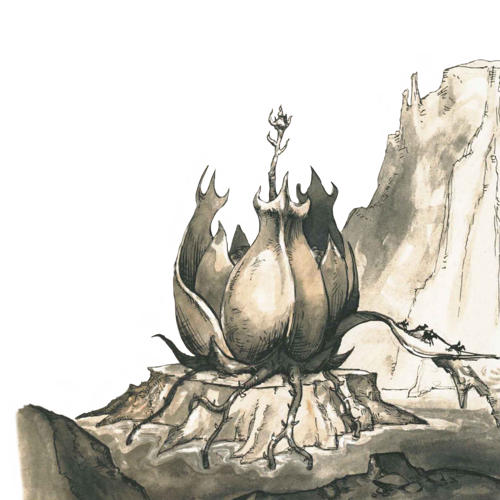Planescape review: The Flower Infernal
For the last three years, I've run a Planescape1 campaign through almost all of its modules. Now, after successfully finishing it, I want to look back and review these adventures, highlighting the pros and cons of each one.
Each module will be rated in three categories, up to 3 points in each:
- Presentation: how easy it is to understand and run the adventure.
- Openness: how open the adventure's scope is, regarding the freedom of choice.
- Quality: Overall quality of the adventure, including the originality and richness of its content, and players' enjoyment.
The full list of currently published reviews is available under the planescape tag.
The Flower Infernal
In which our Heroes encounter some old Enemies and clean up some loose Ends.
- Designers: Colin McComb and Monte Cook
- Source: The Great Modron March2, Chapter X
- Party: 4-6 characters of 7th-9th levels
- Play-time: 1 session
- Locations:
- Outlands / Torch
- Gehenna / Khalas (L1)
Overview
📝 NOTE: This adventure is the finale of the Tacharim knights' trilogy, started with the Ambushed! and Modron Madness chapters, so make sure you didn't skip at least these two in your campaign.
Sir Vaimish Crasad of the Excelsior's Planes-Militant reaches the party to inform them that the order has finally tracked down the Tacharim stronghold. The paladin refuses any assistance and departs, making sure that he's not followed through the portal. Several days later, the party meets Crasad again, but this time, he's barely alive, covered in horrid burns and missing an eye. What's worse, no magical healing (except a wish spell) has any effect on the dying man. Before passing away, Sir Vaimish informs the characters that he was captured by the Tacharim knights, who magically welded modron plates to his body. The paladin's dying wish is for the party to finish what Planes-Militant failed to do — burn down the Flower Infernal — Tacharim knights headquarters in Gehenna.
The most obvious way to Khalas lies through Torch. A brief description of the gate-town is given, but as usual, you can seek additional details in the Player's Primer to the Outlands3 boxed set. Following Crasad's blood trail, the party soon discovers the fortress — a colossal flower resembling the one etched on the Tacharim knights' black armor. The approach to the stronghold is quite dangerous — regular patrols are monitoring the area and must be dealt with in some way first. The module suggests that the optimal approach would be to capture a Tacharim patrol group and borrow their uniforms to infiltrate the Flower, though other tactics are also acceptable and accounted for. The only and obviously losing strategy is an open attack, as Sir Vaimish's example had already shown.
Over 20 keyed locations in the Flower are given short one-paragraph descriptions. Besides 200 guards and 50 knights, statblocks are given to their commander Doran Blackram and the characters' old "friend" — Valran Stonefist. The mad scientist has considerably changed since the last time and now inhabits the body of a decaton. Depending on what terms their previous encounter had ended, he could even be friendly, share his recent discoveries in dealing with the modron madness, and even show them around the place. What if the characters killed him in Chapter V, though? I say, if Varlan's body was still recoverable, it's totally feasible that Tacharim resurrected him to continue the experiments. I would even suggest throwing in some named NPCs from the Rendering Works in Chapter III if they've managed to escape then.
Once inside the Flower, the characters are free to act in any manner they decide upon, gathering intelligence and planning the eventual confrontation. Amid the Tacharim's prisoners, they can also find Crasad's younger brother, Tairish, who was also converted into a modronoid and now barely hangs on the edge of sanity, begging them to kill him. Some minor Tacharim NPCs could provide some useful information if the characters had chosen to disguise themselves in guards' uniforms. Eventually, the characters should discover the "heart" of the fortress and set fire to it, honoring the dead paladin's request. Of course, now they also needed to escape the burning inferno while fighting their way through the enemy force and confronting Doran and Valran if these two weren't dealt with earlier.
Presentation
🖋️🖋️ useable
The room descriptions are concise but clear. The chapters could have been a little more straightforwardly ordered, though. A notable omission amid otherwise competent descriptions is the size and composition of typical Tacharim patrols and guards' squads.
A brief overview of the environmental effects of the inhospitable Gehenna's first level is given, along with an overview of the fortress's defenses and security measures. A minimalistic map of the Flower's two levels plus a more "zoomed-in" layout of the central pod is included. As usual for this book, only the scale is given — not the grid.
Openness
☀️☀️ semi-linear
While the fist half of the adventure could be fleshed out some more (maybe even a small map of the surrounding area so the party can find the fortress by themselves while avoiding the patrols), once the characters get to the Flower, they are given full opportunity to deal with the black knights as they see fit, which is sadly not as often occurence in Planescape adventures as I would like it to be.
Quality
★★★ outstanding
Despite its flaws, the module is quite fun and provides a good opportunity for creative planning and acting "undercover" behind enemy lines. It also brings the Tacharim "arc" to its end, giving the party a chance to avenge their fallen comrades.

Discuss this post on Reddit

